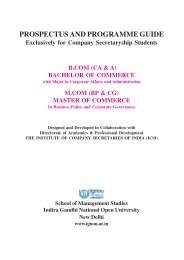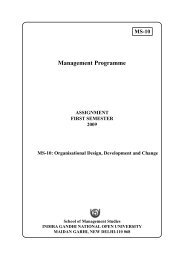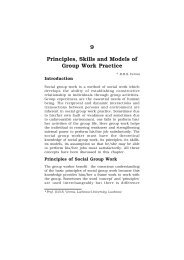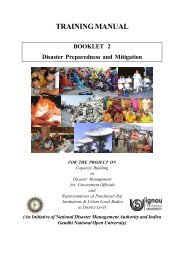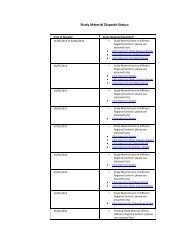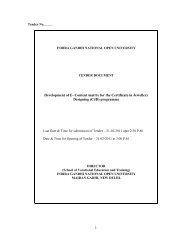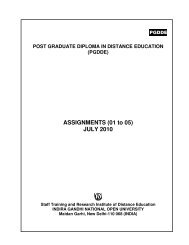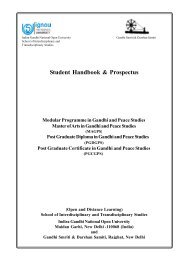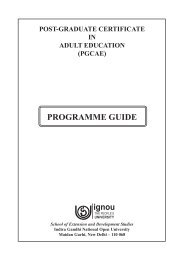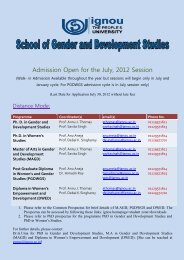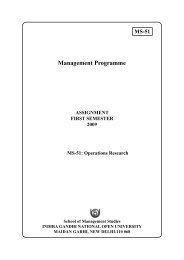Disaster Recovery and the Road Ahead - IGNOU
Disaster Recovery and the Road Ahead - IGNOU
Disaster Recovery and the Road Ahead - IGNOU
You also want an ePaper? Increase the reach of your titles
YUMPU automatically turns print PDFs into web optimized ePapers that Google loves.
Planned cooperation with all government <strong>and</strong> non-government agencies, where such collaboration<br />
adds value <strong>and</strong> increases <strong>the</strong> effectiveness of <strong>the</strong> NGOs<br />
Strategic planning <strong>and</strong> coordination to bring toge<strong>the</strong>r forces <strong>and</strong> resources to achieve optimum<br />
results<br />
DID YOU KNOW?<br />
In 2008, NDRF embarked, in a big way upon <strong>the</strong> community capacity building <strong>and</strong><br />
public awareness programmes in Bihar, which included training of vulnerable people<br />
<strong>and</strong> officials in various districts. NDRF carried out 3 day Flood Preparedness training<br />
programme in 15 vulnerable districts (Bhagalpur, East Champaran, Vaishali, Munger,<br />
Muzaffarpur, Saharsa, Madhepura, Khagaria, Begusarai, Darbhanga, Madhubani, Patna,<br />
Sitamarhi, Samastipur <strong>and</strong> Sheohar) of Bihar before monsoon season at District/Block<br />
levels. More than 15,000 village volunteers, local people, students, state police, <strong>and</strong> also<br />
central <strong>and</strong> state government personnel participated in <strong>the</strong> programme.<br />
Community participation may be viewed as a process that serves one or more of <strong>the</strong> following<br />
objectives:<br />
<br />
<br />
<br />
<br />
Increasing Empowerment: It should be defined as<br />
seeking to increase <strong>the</strong> control of disaster-affected people<br />
over <strong>the</strong> resources <strong>and</strong> decisions affecting <strong>the</strong>ir lives in<br />
<strong>the</strong> disaster aftermath; <strong>and</strong> ensuring <strong>the</strong>ir participation in<br />
<strong>the</strong> benefits produced by <strong>the</strong> society in which <strong>the</strong>y live.<br />
Any project or development activity during <strong>the</strong><br />
rehabilitation process has to be a means of empowering<br />
people, so that <strong>the</strong>y are able to initiate as well as sustain<br />
disaster-mitigation actions on <strong>the</strong>ir own, <strong>and</strong> thus influence<br />
<strong>the</strong> process <strong>and</strong> outcome of development.<br />
Building Beneficiary Capacity: It could be achieved<br />
by ensuring that participants are actively involved in<br />
projects of rehabilitation <strong>and</strong> social consciousness, as well as awareness generation through<br />
formal or informal training.<br />
Enhancing Project Effectiveness: Community participation tends to enhance project<br />
effectiveness when <strong>the</strong> involvement of beneficiaries contribute to better project formulation,<br />
design <strong>and</strong> implementation, <strong>and</strong> leads to better match of project services with beneficiary needs<br />
<strong>and</strong> constraints.<br />
Sharing Project Costs: An object of community participation is <strong>the</strong> desire to share <strong>the</strong> cost<br />
of <strong>the</strong> project with <strong>the</strong> people it serves. Thus, beneficiaries may be expected to contribute<br />
labour, or o<strong>the</strong>r infrastructure resources to undertake or maintain <strong>the</strong> project.<br />
The advantages of community participation in <strong>the</strong> recovery phase are:<br />
<br />
Systematic identification of problems<br />
Source: Community Empowerment/<br />
chcsi.org<br />
24



